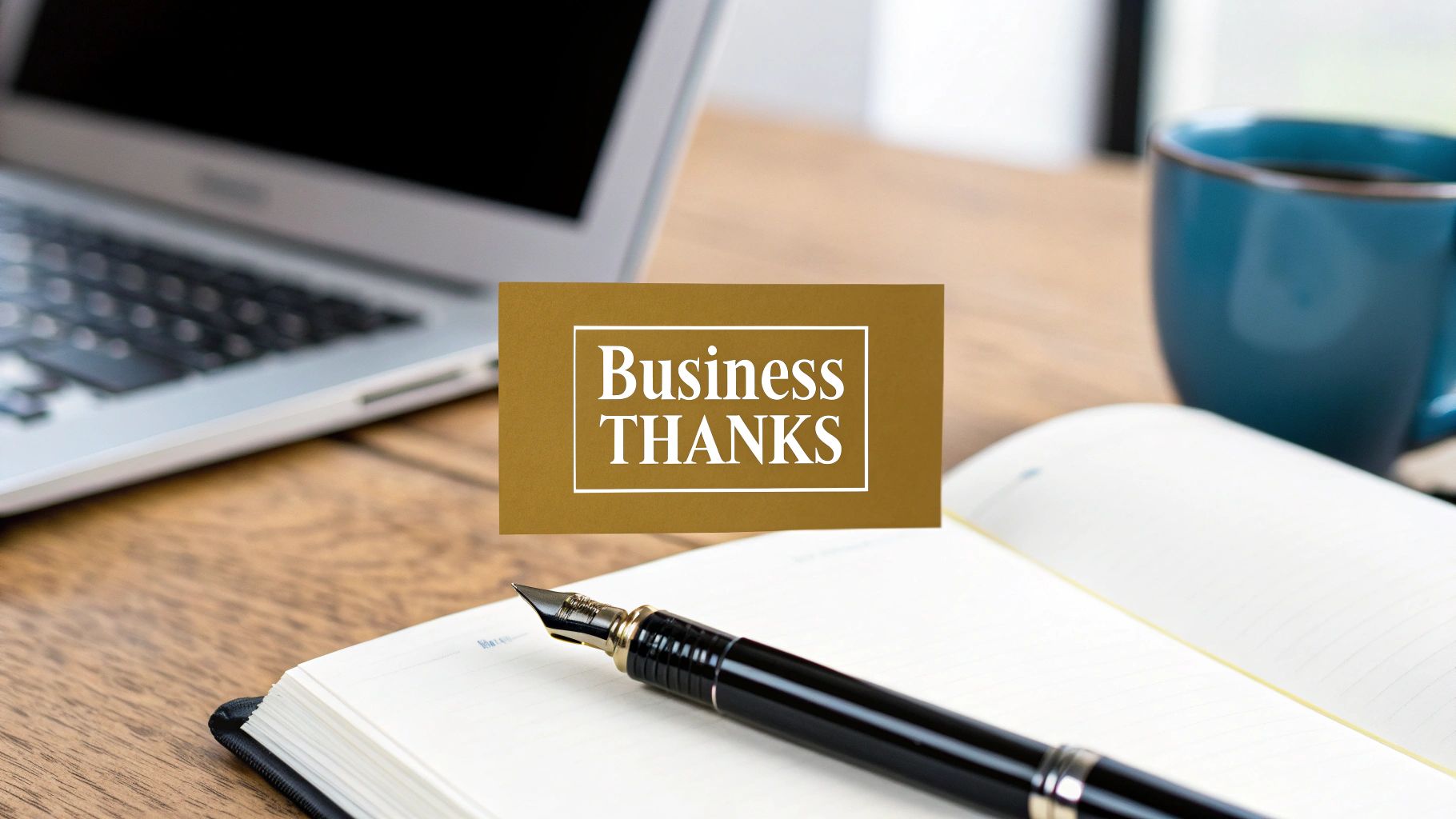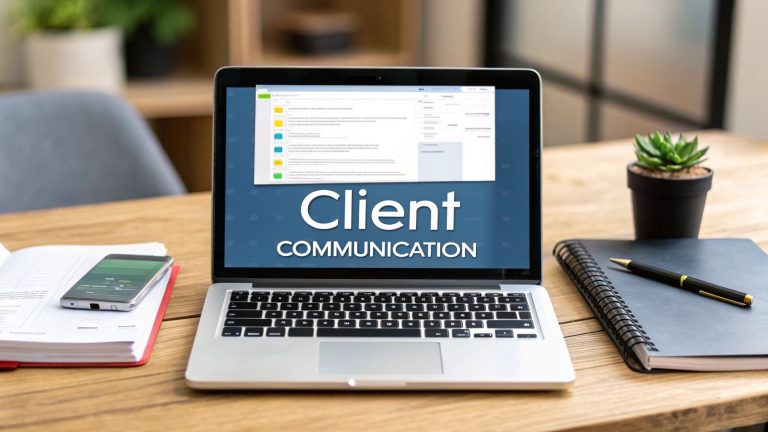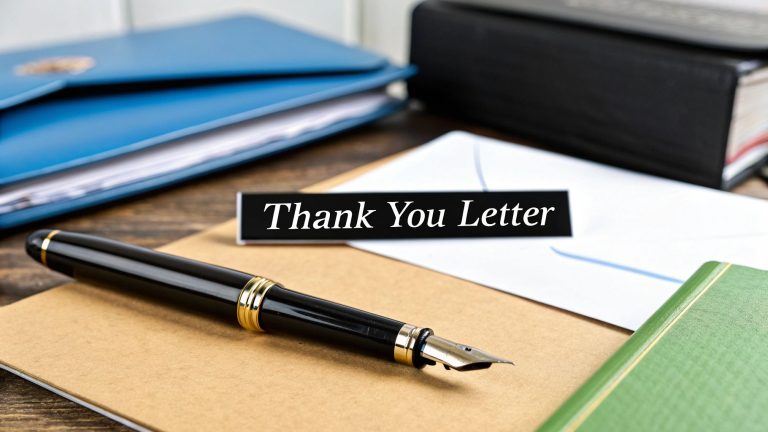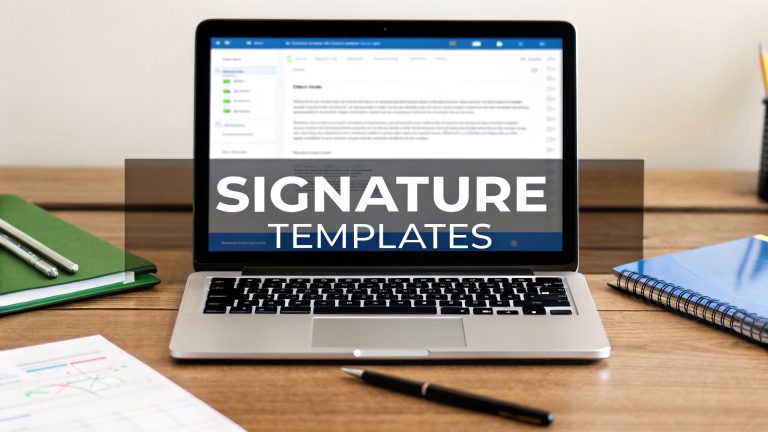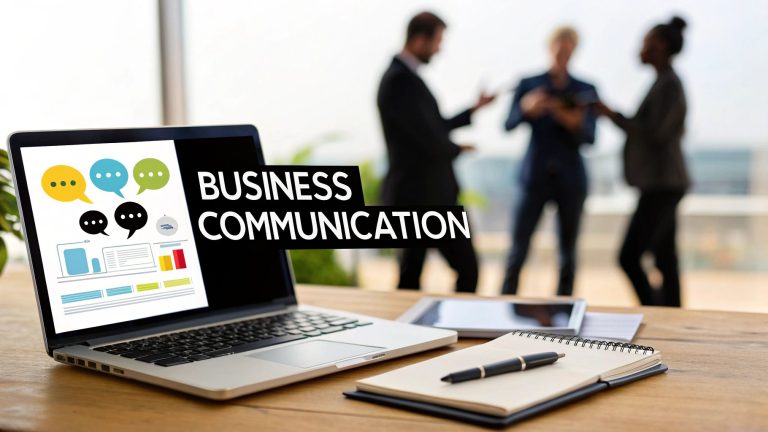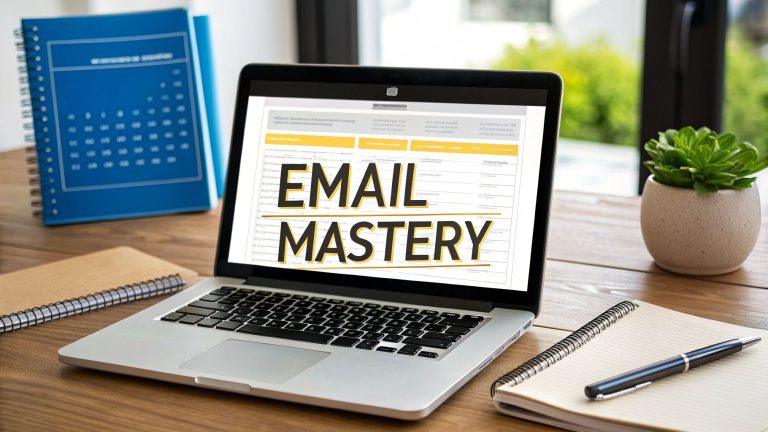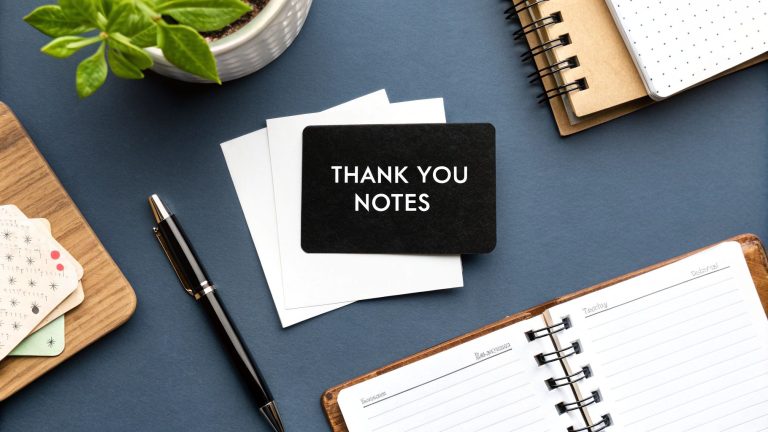In a world buzzing with digital noise, a simple thank you letter for business has become a surprisingly powerful tool for building real connections. It’s more than just good manners; it's a smart way to turn a single transaction into a long-term relationship by making people feel genuinely seen and valued.
Why Gratitude Is Your Greatest Business Asset
In business, it's often the small gestures that make the biggest difference. We rely on emails and instant messages for speed, but a well-written thank you letter is what truly cuts through the clutter. It tells someone you invested real time and thought into your message, a rare commodity these days. This simple act of gratitude can completely change the dynamic of a relationship.
When a client gets a personal note, they don't just feel like another number on a spreadsheet; they feel like a valued partner. This builds a kind of loyalty that discount codes and automated marketing emails just can't touch. The same goes for employees. A specific thank you from a manager makes a team member feel recognized and appreciated, which does wonders for morale and engagement—far more than any generic company-wide announcement.
The Psychology of a Thank You
The impact of a thank you letter isn't just a nice idea; it's backed by psychology. We all have a fundamental need to feel appreciated. When you acknowledge someone's contribution, purchase, or partnership, you're validating their choice to work with you and strengthening that social bond.
This infographic breaks down how a simple act of gratitude creates a positive cycle for your business.
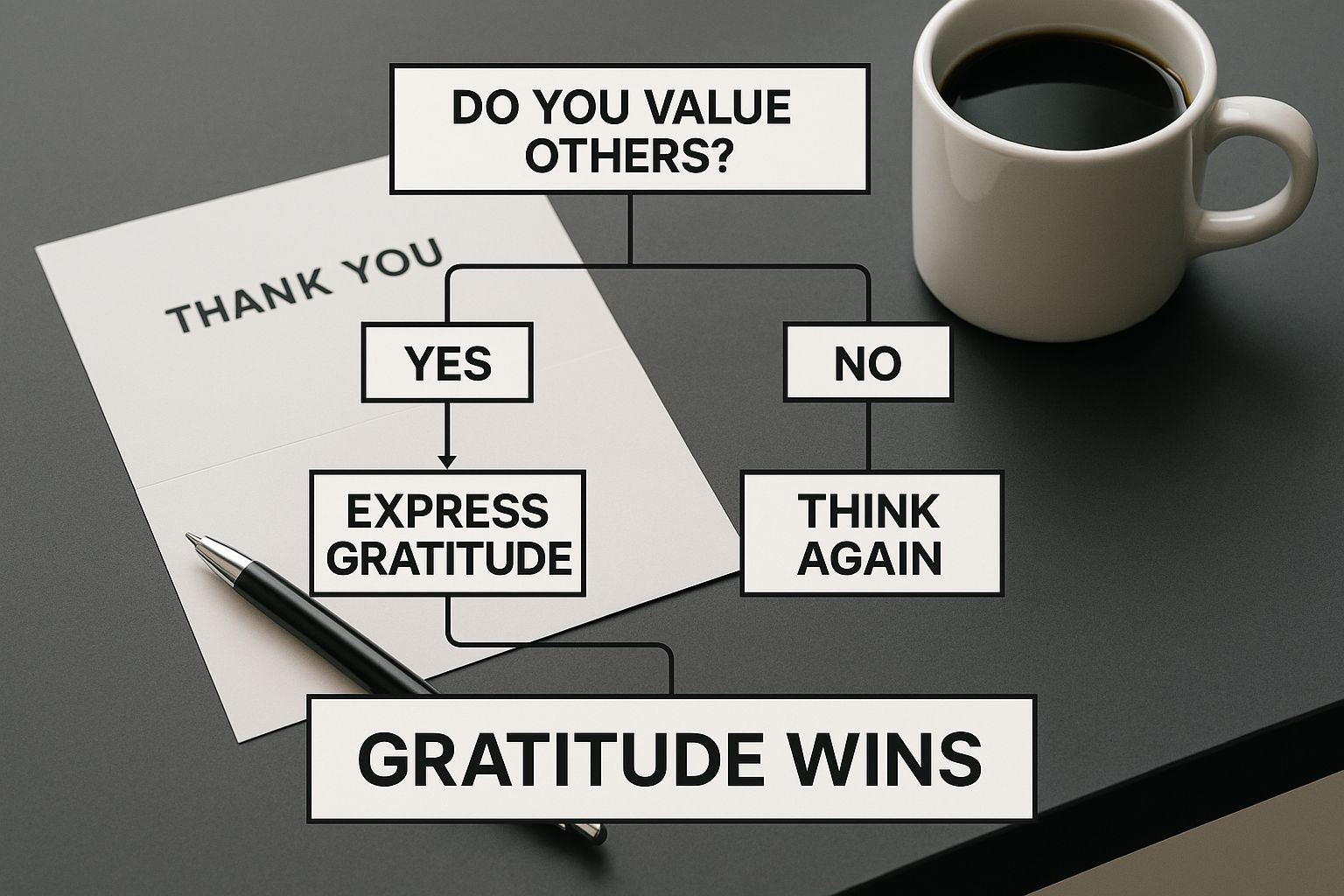
As you can see, expressing gratitude isn't just about being polite. It's a strategic move that drives loyalty and shapes how people see your company. Many people actually underestimate just how well a thank you note will be received. A University of Chicago study found that recipients consistently felt more elated than the senders ever expected. This proves that any awkwardness you might feel about writing a note is usually all in your head. The positive impact is almost always bigger than you think.
Turning Appreciation into Action
Once you've created that positive feeling, it's natural to build on it. A client who feels appreciated is often more than willing to become an advocate for your brand. This is a great time to think about a follow-up. Understanding how to effectively ask for testimonials can turn that goodwill into powerful social proof for your business.
"A well-crafted thank you letter for business isn't an expense; it's an investment in future loyalty. It's the bridge between a completed transaction and a continued relationship."
This mindset shifts gratitude from a passive feeling into an active strategy for growing your business. And if you're planning to send a physical letter, getting the logistics right is part of the process. For more on that, you can check out our guide on https://lettergenerator.co/sending-letters-postage-special-cases/. It’s a small detail, but it helps ensure your thoughtful message arrives just right.
Anatomy of an Unforgettable Thank You Note
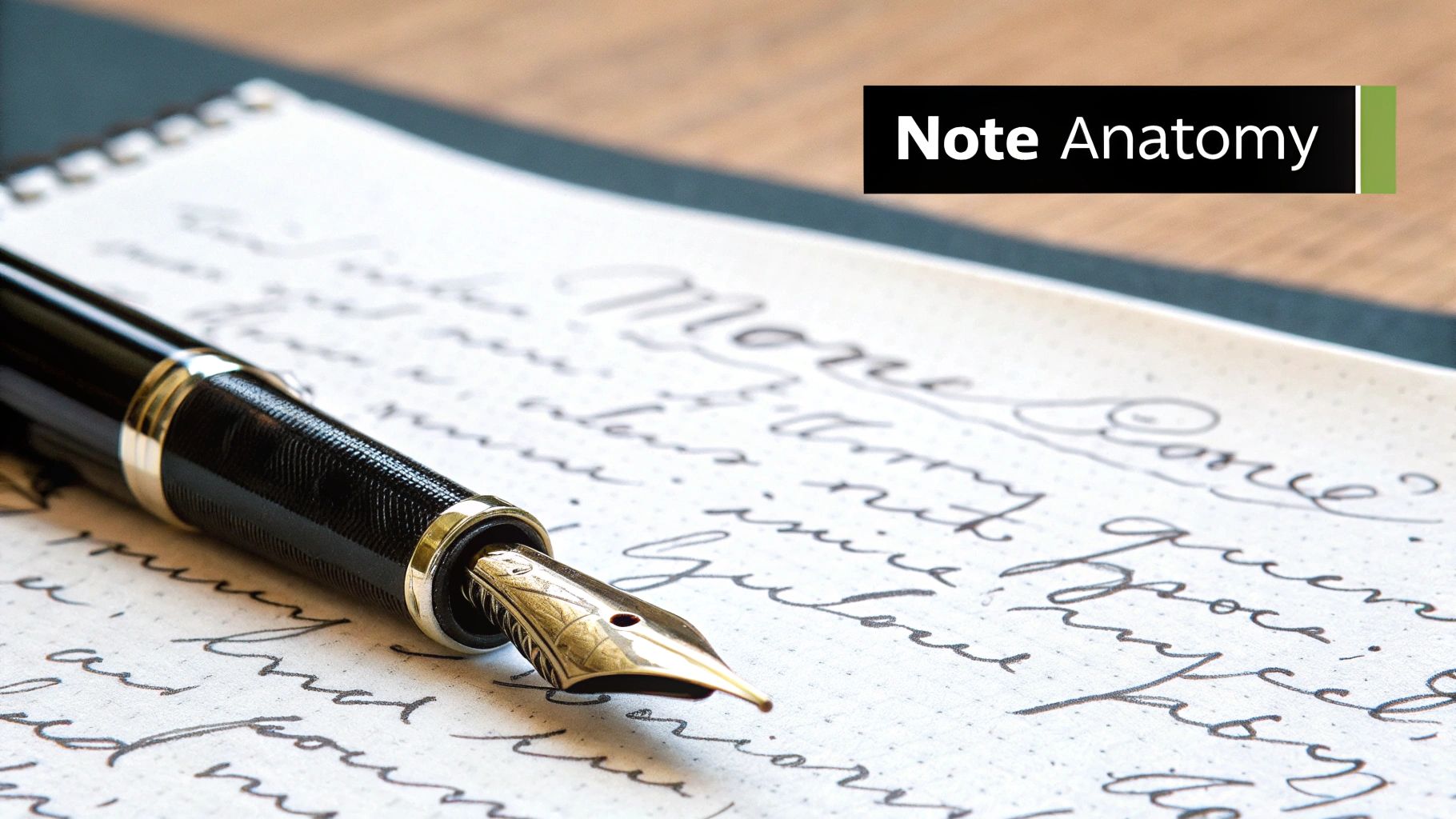
Let's move past the cookie-cutter templates. A truly great thank you letter for business is so much more than a collection of polite phrases. Think of it as a carefully crafted message, built piece by piece, to make someone feel genuinely seen and appreciated. It’s this structure that turns a simple note into a memorable gesture.
Every element has a job to do, from the greeting that sets the tone to the closing that strengthens your connection. The real goal is to write something that feels personal and sincere—the exact opposite of a copy-and-paste job.
Start with a Personalized Salutation
How you begin the letter sets the stage for everything that follows. While "Dear Mr. Smith" is a safe, formal option, a slightly warmer greeting like "Dear John" often feels more natural in today's business world, especially if you've built some rapport.
Whatever you do, steer clear of cold, generic openings like "To Whom It May Concern." That’s an instant sign that your message is impersonal. Using their first name shows you’re writing to them, not just sending a blast. It’s a small detail that makes a big difference.
Craft a Specific and Sincere Body
This is the heart of your message—where your gratitude really comes to life. A simple "thank you for your business" just won't cut it. To make your note memorable, you absolutely have to be specific. What, exactly, are you thankful for?
Pinpoint a particular detail from your interaction. For instance, instead of a vague "Thanks for the meeting," try something with more substance: "Thank you for taking the time to meet with me yesterday. I especially valued your insights on the new marketing campaign." This kind of detail proves you were paying attention and genuinely valued their input.
If you need a refresher on the basics of laying out your message, our guide on how to format a letter is a great resource.
Here are a few ways I’ve seen people add meaningful detail that works:
- Reference a specific conversation point: "Your advice on streamlining our logistics was incredibly helpful."
- Acknowledge their effort: "I really appreciate how quickly your team was able to complete the project, especially ahead of schedule."
- Mention a positive outcome: "Because of your referral, we were able to connect with a fantastic new partner."
This is how a thank you note goes from a mere courtesy to a powerful tool for building real relationships.
The most impactful thank you notes aren't about the grandest gestures. They are about noticing and acknowledging the small, specific details that made an interaction meaningful.
Conclude with a Forward-Looking Closing
The way you end the letter is just as important as how you begin it. Your closing should echo the positive, grateful tone of the note, but—and this is key—it shouldn't feel like a sales pitch. You're here to express thanks, not to ask for the next deal.
Simple and sincere phrases always work best. I like to end with a statement that looks to the future, showing my desire to keep the relationship going.
A Few Effective Closing Lines:
- "I look forward to our continued partnership."
- "We are excited to work with you again soon."
- "I truly value your support and expertise."
Finish it off with a professional sign-off like "Sincerely," "Best regards," or "Warmly," followed by your typed name and title. It’s a clean, genuine finish that leaves a lasting positive impression.
Crafting Your Message with Authenticity
The real magic of a business thank-you letter isn't in the template; it's in the personality you pour into it. Anyone can fire off a generic, pre-written note. But a message that sounds like you—that's what makes someone stop, read, and feel a genuine connection. This is where you graduate from basic courtesy to actual relationship-building.
Finding your voice is all about striking the right balance between professional and personable. You don't have to be stiff and formal to be taken seriously. In fact, a slightly more relaxed tone often feels far more sincere. Just think about how you'd thank someone face-to-face. Your writing should capture that same energy.
Move Beyond Generic Phrases
The fastest way to make your letter feel robotic is to lean on tired, generic phrases. "Thank you for your business" is the perfect example. Sure, it's polite, but it's also completely impersonal. It gets the job done, but it won’t be remembered minutes later.
Real authenticity lives in the details. Your goal is to turn a vague platitude into a specific acknowledgment that proves you were actually paying attention.
Here’s a quick before-and-after to show what I mean:
- Before: "Thank you for meeting with me today."
- After: "Thank you again for your time today. I especially valued your insights on the Q3 logistics plan—it gave me a lot to think about."
See the difference? The second version points to a specific detail from the conversation. This tiny shift tells the recipient their contribution wasn't just heard, it was genuinely valued. It makes your gratitude feel earned.
A truly authentic thank-you note answers the question, "What specifically am I grateful for?" If your message could be sent to anyone on your contact list, it’s not personal enough.
Finding Your Sincere Voice
Writing with sincerity doesn't mean you have to get overly emotional or casual. It just means writing in a way that feels natural. If you’re not an exclamation point person, don't force them into your letter. If your style is more direct and to the point, own it.
Let the relationship guide your tone. A note to a partner you've worked with for a decade will naturally sound different than one you're sending to a brand-new client. It’s a lot like the thought that goes into writing a letter to a friend, where your shared history dictates the language you choose. Your professional relationships deserve that same level of care.
Here are a few practical tips to get more of you into your next letter:
- Write Like You Speak: Once you have a draft, read it out loud. Does it sound like something you'd actually say in a conversation? If it sounds clunky or overly formal, rewrite it until it flows naturally.
- Focus on "You," Not "I": Flip the script to center on the recipient. Instead of saying, "I was so happy to close the deal," try something like, "Your clear communication and decisiveness made this entire process a pleasure."
- Mention a Shared Moment: If it feels right, reference a small, positive detail from your interaction. It could be a shared laugh over a bad cup of coffee or an interesting point they made that stuck with you. These little moments build an immediate personal connection.
Proven Thank You Letter Examples for Any Situation
Theory is great, but seeing a well-crafted thank you letter for business in action is where the real learning happens. Let’s shift from principles to practice and look at some examples you can adapt for common situations. Each one is built with a specific goal, demonstrating how small tweaks in tone and detail can have a massive impact.
Think of these less as templates and more as strategic starting points. You'll notice they all skip the generic fluff and get straight to a specific, authentic reason for the gratitude.
Thanking a New Client After a Project Kickoff
Kicking off a new client relationship on the right foot is absolutely critical. This first thank-you note really sets the tone for your entire partnership. You want it to be enthusiastic and professional, ultimately reassuring them that they made the right choice in hiring you.
Here’s how that might look:
Subject: Great to kick things off!
Hi Jessica,
Thank you again for your time and energy in our kickoff meeting today. I left the conversation feeling incredibly excited about the goals we've set for the Q3 marketing campaign.
I especially appreciate the clarity you provided on your target audience—your insights have already given my team some fantastic ideas for our initial creative concepts. We're already hard at work and look forward to sharing our first drafts with you next week.
We are thrilled to be your partner on this project.
Best regards,
David Chen
Why does this work so well? It’s specific ("Q3 marketing campaign"), it points to a valuable contribution from the client ("clarity you provided on your target audience"), and it establishes a positive, forward-looking vibe. It proves you were listening and are already taking action.
Appreciating a Partner for a Key Referral
In business, a referral is one of the highest compliments you can receive. Thanking someone for it isn't just polite; it's essential for strengthening that relationship and encouraging more recommendations down the road. Your note should be genuinely grateful and briefly touch on the positive outcome.
If you're looking for more detailed advice on this, you can find a perfect follow-up email template and best practices that can be easily adapted for this scenario.
Acknowledging an Employee Who Went the Extra Mile
Gratitude isn't just for clients. Showing appreciation internally is a powerful way to boost morale and build a great company culture. The trick is to be timely and incredibly specific about what the person did and why it mattered.
For instance:
Subject: Your amazing work on the Apex account
Hi Maria,
I wanted to personally thank you for the outstanding work you did to resolve the logistics issue for the Apex account this week. I know you stayed late to coordinate with the shipping carrier, and your dedication did not go unnoticed.
Because of your quick thinking and commitment, we were able to meet the client’s deadline and secure their satisfaction. It's that level of ownership that makes our team so successful.
Thank you for going above and beyond. Your hard work is truly appreciated.
Sincerely,
Sarah Jones
This message hits the mark because it names the specific project ("Apex account"), details the exact action ("stayed late to coordinate"), and connects it directly to a positive business result ("meet the client's deadline"). This makes the employee feel truly seen and valued. Don't underestimate the power of this; one study found that 70% of donors would increase their contributions if they received warm, appropriate communication.
These examples, much like our email after interview sample, are designed to be adapted to your unique voice and situation.
Building a Culture of Gratitude Internally
We often focus our energy on sending thank-you letters to clients and partners, but some of the most powerful results come from turning that gratitude inward. Your team is your single greatest asset. Creating an environment where appreciation is the norm—not the exception—is one of the best things you can do for morale, engagement, and keeping your best people around.
When you take a moment to acknowledge your team’s hard work, you make them feel like valued individuals, not just cogs in a machine. This can be as simple as celebrating a work anniversary or recognizing someone who stayed late to get a presentation just right. A specific, handwritten note from a manager or even a peer can completely change an employee's week, reinforcing that their contributions are seen and genuinely valued.

Why Internal Thank-You Notes Pack Such a Punch
It’s easy to underestimate the power of a simple "thank you" in the workplace. It's a zero-cost tool with an incredible return on motivation. The data backs this up. Recent employee appreciation studies show that about 65% of employees actually prefer non-monetary rewards—like a heartfelt note—over cash.
Even more telling, 36% of women specifically said they prefer written thank-you notes as a way to feel seen and validated for their work. It's clear that a thoughtful letter is a universally effective way to boost morale. You can dig into more of these fascinating insights in the full 2025 study on employee recognition.
Seizing the Right Moments for Internal Gratitude
Weaving appreciation into your company’s daily rhythm doesn't need to be complicated. The real trick is to be consistent and, most importantly, authentic.
Here are a few perfect opportunities to send a thank-you note to a colleague or team member:
- After a Big Project Wraps: Once a team nails a tough project launch, take time to acknowledge the collective effort and maybe even call out a few standout individual contributions.
- When Goals Are Crushed: Did someone on your team blow their quarterly targets out of the water? That definitely calls for a personal note.
- For Living the Company Values: If you spot a coworker perfectly embodying one of your core values, like "customer-first" or "innovate fearlessly," recognize it.
- On Work Anniversaries: A personal note celebrating a milestone anniversary shows you value an employee's long-term commitment and aren't just letting it pass by.
A culture of gratitude starts with leadership, but it's sustained by everyone. When you encourage peer-to-peer recognition, you create a supportive ecosystem where everyone feels empowered to celebrate each other's great work. That strengthens the entire team from the ground up.
Got Questions About Business Thank You Letters? Let’s Clear Things Up.
Even the most seasoned pros can get tripped up by the finer points of business etiquette. When it comes to something as important as a thank-you letter, you want to get it right. Let’s tackle some of the most common questions that pop up, so you can send every note with confidence.
Think of this as your go-to guide for showing gratitude the right way.
How Quickly Do I Need to Send It?
Timing is huge. You want your thank-you to land while the positive interaction is still fresh in their mind. The sweet spot is within 24-48 hours.
Waiting too long can make your gesture feel like an afterthought, and you want it to feel genuine.
- If you're sending an email: Aim for the same day or the next morning. The immediacy of email reinforces your efficiency and shows you're on top of things.
- If you're sending a handwritten note: Get it in the mail within that same 48-hour window. Sure, the post office takes a few days, but your promptness in sending it speaks volumes.
Is an Email Okay, or Should I Always Handwrite It?
This is a classic question, and the answer is: it depends. While a handwritten note has a certain old-school charm that stands out, an email is often the smarter, more practical choice.
An email is perfect for quick, professional follow-ups. Think about thanking someone after a productive team meeting, an initial sales call, or a quick chat on the phone. In fast-moving industries, a timely email is often expected and appreciated.
A physical, handwritten card is best saved for moments that carry more weight.
Think about landing a huge deal, receiving a career-changing referral, or thanking a mentor who really went out of their way for you. The extra effort you put into a physical note signals that the gesture was truly special and not just another Tuesday.
What are the Biggest Mistakes People Make?
A thank-you note can backfire if you're not careful. I've seen a few common missteps trip people up time and time again.
The biggest mistake? Turning your thank-you into a sales pitch. Don't do it. Your note should be about one thing and one thing only: expressing gratitude. Tacking on a request for another meeting or pitching a new idea can make the whole thing feel insincere and transactional.
Other common traps include:
- Being too generic: Avoid clichés and mention something specific from your conversation.
- Typos and errors: Nothing kills professionalism faster than a glaring typo. Proofread it twice.
- Sending it too late: As we covered, timing is key.
- Making it too long: Keep it focused. A few thoughtful paragraphs are all you need. Your goal is a heartfelt note that respects their time.
